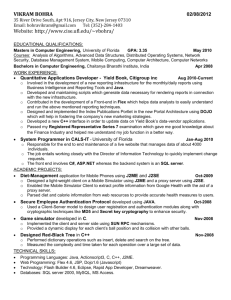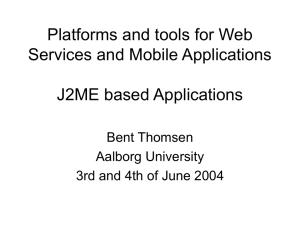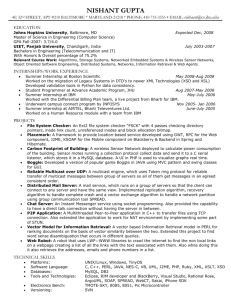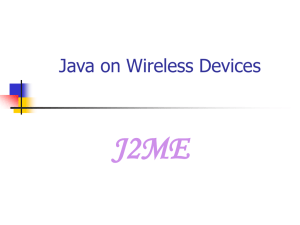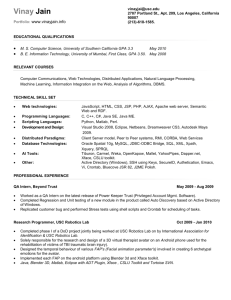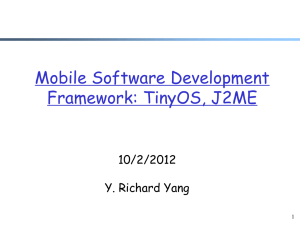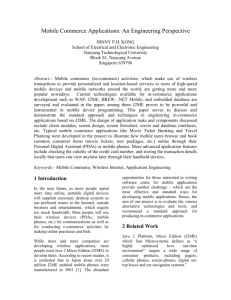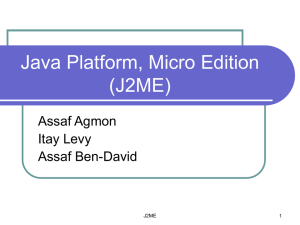Java 2 MicroEdition
advertisement
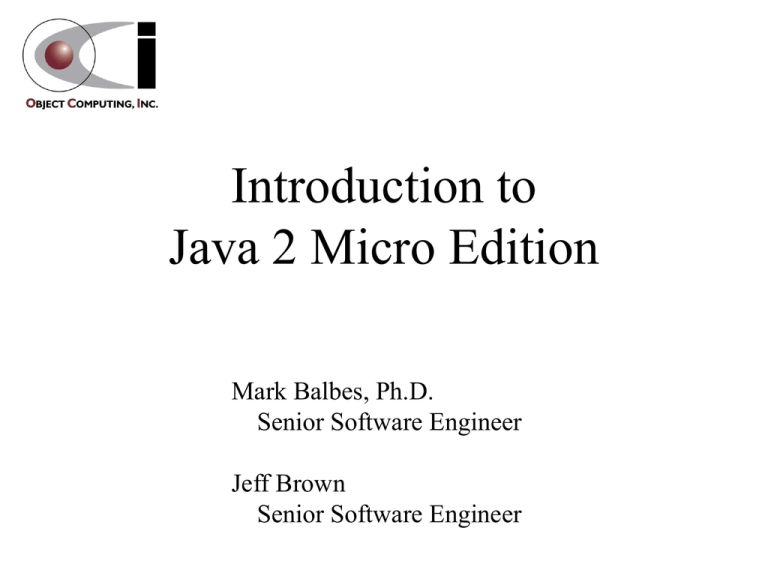
Introduction to
Java 2 Micro Edition
Mark Balbes, Ph.D.
Senior Software Engineer
Jeff Brown
Senior Software Engineer
What is J2ME
•
•
•
•
•
Java platform for small devices
A subset of Java 2 Standard Edition
Complementary technology to WAP/WML
For programming the Palm
For programming wireless devices (e.g
mobile phones)
J2ME
(2)
• Motorola
J2ME-Enabled Devices
– i85s and i50sx iDen phones
– Applications are downloaded and installed via a special cable
http://commerce.motorola.com/iupdatephone/main/j2me_softcat.cfm
• NTT DoCoMo
– Japanese phone company
• ~80% of wireless internet users are in Japan
– iMode and iAppli support
i85s
• Research In Motion
– CLDC and MIDP compliant
– http://www.rim.net/
• Palm and compatibles
• WinCE devices
P503i
RIM BlackBerry
J2ME
(3)
Configurations and Profiles
•
•
•
•
•
CDC - Connected Device Configuration
CLDC - Connected Limited Device Configuration
MIDP - Mobile Information Device Profile
PDAP - Personal Digital Assistant Profile
Personal Profile
Personal
MIDP PDAP
CDC
CLDC
JVM
KVM
Host Operating System
J2ME
(4)
CLDC
Connected Limited Device Configuration
• Specification Version 1.0
• Hardware Requirements
– 160 - 512 kB of memory
– 16 or 32 bit processor
– network connectivity (possibly wireless)
• No floating point support
• Deliver applications dynamically
J2ME
(5)
CLDC (Cont’d)
Connected Limited Device Configuration
• CLDC addresses
–
–
–
–
–
–
Java languages and virtual machine features
Core Java libraries
Input/output
Networking
Security
Internationalization
J2ME
(6)
CLDC (Cont’d)
Connected Limited Device Configuration
• CLDC does not address
–
–
–
–
Application life-cycle management
User interface functionality
Event handling
High-level application model
• These can be addressed in profiles
J2ME
(7)
CLDC
What’s been removed
•
•
•
•
•
•
•
Floating point
Java Native Interface
User-defined class loaders
Reflection
Thread groups and daemon threads
Finalization
Weak references
J2ME
(8)
CLDC Security
• Less memory-consuming than J2SE model
• Sandbox
– No user-defined class loaders
– Classes loaded at native level
• No native method calls except from JVM
• System classes cannot be overridden by
programmer
J2ME
(9)
Programming the Palm
• Development Environment
– J2ME CLDC API
• Contains a subset of the standard J2SE classes
– J2ME KJava API
• GUI components
• Access to Palm database
• Access to IR port
– JBuilder Handheld Express
– POSE Palm Emulator
J2ME
(10)
Already superceded.
Not supported!
• io
Programming the Palm
CLDC Packages
– InputStream, OutputStream, Reader, Writer
• lang - No floating point support
• util
– Enumeration, Calendar, Date, Hashtable,
Random, Stack, TimeZone, Vector
• javax.microedition.io
– Connection, Datagram, InputConnection,
OutputConnection, Connector
J2ME
(11)
Programming the Palm
KJava GUI Components
• Spotlet
– Container for other components
– Handles events
• All events go to the spotlet.
• Spotlet must send events to the contained components.
– Only one spotlet can be registered
• The registered spotlet is displayed.
• The registered spotlet receives all events from keys and
screen.
J2ME
(12)
Programming the Palm
HelloSpotlet
public class HelloSpotlet extends Spotlet {
private Graphics g;
Graphics must be managed
manually!
private Button quitButton;
private String message = "Hello Spotlet!";
public HelloSpotlet() {
Cannot specify the
size of the button.
g = Graphics.getGraphics();
g.clearScreen();
quitButton = new Button("Quit", 5, 125);
quitButton.paint();
g.drawString(message, 5, 5, Graphics.PLAIN);
}
J2ME
(13)
Programming the Palm
HelloSpotlet (Cont’d)
public void penDown(int x, int y){
if (quitButton.pressed(x, y)) {
System.exit(0);
}
Pass screen
}
events to the button
public static void main(String[] args) {
new HelloSpotlet().register(Spotlet.NO_EVENT_OPTIONS);
}
}
Register for screen events only. No key events
J2ME
(14)
Programming the Palm
Deploy & Test HelloSpotlet
• Use JBuilder Wizard to create .prc file
• Command line
java palm.database.MakePalmApp
• Install into POSE
• No debugger
J2ME
(15)
Programming the Palm
KAWT Project
•
•
•
•
•
•
Implementation of the AWT classes
Can make GUIs that work in J2ME & J2SE
Open source
Not part of J2ME
Lightweight
Clean-room implementation
J2ME
(16)
Building the Conduit
• Synchronizes data with desktop
• Java Conduit Development Kit
– Claims to require Visual Café
– MS Windows
– Supports generic conduits
J2ME
(17)
What is MIDP?
• Provides APIs for building software on mobile
devices with limited resources.
• Works on top of the Connected Limited Device
Configuration (CLDC)
J2ME
(18)
Where does MIDP fit in the Java
platforms?
– Works with CLDC
– Runs in the KVM
– Examples of devices:
mobile phones
pagers
BlackBerry devices
personal digital assistants
From http://java.sun.com/products/midp/
J2ME
(19)
HelloMIDLet
import javax.microedition.midlet.*;
import javax.microedition.lcdui.*;
public class HelloMIDlet extends MIDlet implements CommandListener {
private Command exitCommand;
private Display display;
public HelloMIDlet() {
display = Display.getDisplay(this);
exitCommand = new Command("Exit", Command.SCREEN, 2);
}
public void startApp() {
TextBox t = new TextBox("Hello MIDlet", "Hello World!", 256, 0);
t.addCommand(exitCommand);
t.setCommandListener(this);
display.setCurrent(t);
Make TextBox the current screen
}
public void pauseApp() {}
public void destroyApp(boolean unconditional) {}
public void commandAction(Command c, Displayable s) {
if (c == exitCommand) {
Signals the MIDlet to terminate and enter the Destroyed state.
destroyApp(false);
Notify the application manager that
notifyDestroyed();
the MIDlet has entered the Destroyed state
}
}
}
J2ME
(20)
J2ME Wireless Toolkit
• J2ME Wireless Toolkit 1.01
– http://java.sun.com/products/j2mewtoolkit/
– Integrates with Sun Forte IDE
• J2ME Wireless Toolkit 1.02
– adds debugging capabilities
– adds new emulators
– early access version available (as of 6/3/01)
J2ME
(21)
J2ME Wireless Toolkit Emulators
J2ME
(22)
Final thoughts
It’s back with
J2ME for Palm!
• What happened to write-once, run
anywhere. Now there are different
configurations and profiles to write to.
• How many developers can actually write for
phones? Access may be controlled by the
phone companies.
• CLDC & KJava provides a more familiar
development paradigm.
Wireless SIG
J2ME
(23)
Wireless SIG
• A joint special interest group of the St.
Louis Web Developers Organization and the
St. Louis Java User’s Group
• http://www.stlwebdev.org
• First meeting is on Tuesday, July 24 at 6:30
p.m. in this auditorium.
• I will be talking about J2ME MIDP
• Contact Mark Balbes (me) to be a speaker
at mark@balbes.com
J2ME
(24)
References
•
•
•
•
•
•
•
CLDC Specification
http://java.sun.com/aboutJava/communityprocess/final/jsr030/index.html
MIDP Specification
http://java.sun.com/aboutJava/communityprocess/final/jsr037/index.html
J2ME Archive http://www.billday.com/j2me/index.html
http://www.kvmworld.com/
Palm Emulator (POSE) http://www.palmos.com/dev/tech/tools/emulator/
J2ME Wireless Toolkit http://java.sun.com/products/j2mewtoolkit/
Conduit Development Kit - Windows Java Edition
http://www.palmos.com/dev/tech/tools/cdk/java
J2ME
(25)
